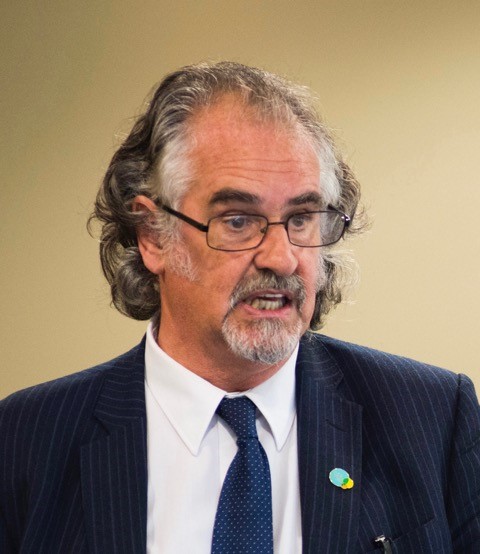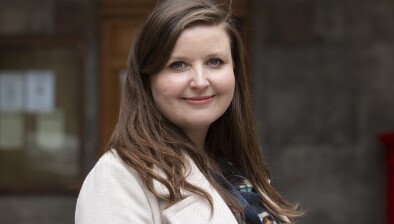Craig Sanderson: Let’s all work together to ensure there is enough truly ‘affordable’ housing in Edinburgh

Craig Sanderson
Former Link chief executive and member of the Edinburgh Poverty Commission, Craig Sanderson, outlines how housing can help overcome poverty in Edinburgh.
One of the most devastating causes of poverty in Edinburgh is the mushrooming cost of sustaining a secure, comfortable home to buy or rent. Surely this is a basic human right? We have to recognise that a house is somewhere to live not a commodity to create personal wealth and to be traded for profit.
Our obsession with home ownership has led to an explosion of house prices and (because they are closely linked) private sector market rents. The best solution is to provide enough good quality social housing at rents which households on low or limited fixed incomes can afford and can enjoy satisfactory levels of health and wellbeing living in them.
This in turn requires sufficient capital subsidy from the Scottish Government.
This is not a ‘grant’ to the council or housing association landlord but an investment in the health and wellbeing of current and future tenants and the Scottish nation as a whole (especially now Right to Buy is scrapped).
In 2016 the Scottish Government set a laudable but challenging target of 50,000 new ‘affordable’ homes to be completed by 2021, 35,000 of which were to be for social rent. Since then, the combined efforts of the local authorities and Registered Social Landlords (RSLs, aka housing associations) in Scotland had ensured that at least the social homes target would have been met – until the arrival of the COVID-19 pandemic.
Nevertheless, some observers/commentators argued throughout this period that this was not sufficient to clear the backlog and meet new needs arising from an ageing population, asylum seekers, refugees, increasing ‘homelessness’, etc.
Shelter Scotland, the Scottish Federation of Housing Associations (SFHA), the Chartered Institute of Housing in Scotland (CIoHS) had stated more than six years previously that 10,000 new homes for social rent per annum were required. We never got close, the best being 7,000 in one year during the aforementioned ‘drive’.
Reflecting both on the target in principle and the shortfall in practice, SFHA, Shelter and CIoHS co-commissioned a research report Affordable Housing Need in Scotland post-2021. It was a substantial piece of work, interrogating housing need by region and concluded that 53,000 new ‘affordable’ homes were needed within the following five years. This was immediately welcomed by all three of the commissioning bodies, although the report was silent on the proportion of this total which needed to be for social rent.
Subsequently, Shelter Scotland qualified its approval (“We know that Scotland needs another 53,000 affordable homes, including 37,100 for social rent, to meet need.”) - and the SFHA and CIoHS called for 66% and 70% respectively to be for social rent. These targets were repeated in a report in July 2020 to Scottish Ministers who accepted the recommendations ‘in principle’ but made no commitment in practice.
At the same time, the Edinburgh Poverty Commission (EPC) was preparing its final report which would include a call for the delivery of an adequate supply of new quality homes for social rent during the next ten years. (The importance of the need for SOCIAL rather than ‘affordable’ housing cannot be overstated. The term ‘affordable’ is basically meaningless and is both ‘spun’ and interpreted in different ways.)
To some, ‘affordable’ means any tenure type which is less expensive than outright purchase or private sector renting. This term includes ‘low-cost home ownership’ (LCHO e.g., Shared Ownership) and ‘Intermediate’ or ‘Mid-market’ Rent (MMR) and social housing to rent. Others (including the EPC) define it as LCHO and MMR only. Social housing is in our view available at a rent level which allows households on low or fixed incomes to meet their other costs of living while maintaining good health and wellbeing.
EPC spent 18 months talking (and, more importantly, listening) to many people who said that anything more than a social rent level would be way beyond their reach.
This demonstrated that, in Edinburgh at least, the proportion of new ‘affordable’ supply which is for social housing should be substantially higher.
In September 2020 EPC called for CEC to double its previous target of new social housing supply to 2,000 per annum for at least five years. To its credit, CEC accepted most of the EPC’s ‘calls’ regarding the eradication of poverty in its subsequent End Poverty in Edinburgh Delivery Plan 2020-30. Nevertheless, CEC did not approve our call for doubling new social housing supply.
I can understand why – to achieve that aim it requires total commitment, concerted effort, help and support not only from CEC itself but also the Scottish Government (particularly), other statutory authorities, the RSLs, private developers, tenants and all their representative bodies (those I’ve mentioned above - and Convention of Scottish Local Authorities, the Edinburgh Affordable Housing Partnership, TPAS, TIS, Homes for Scotland, The Edinburgh & South East Scotland City Region Deal, ETF, etc.). In June the consultation draft Edinburgh and South East Scotland City Region Deal Regional Prosperity Framework (2021-41) was published.
It has a couple of a major flaws - social housing is not mentioned and it fails to recognise the potential contribution that housing associations, voluntary/charitable organisations and social enterprises can make to local and regional economies and communities.
And then in July the Scottish Government’s research report The Value, Incidence and Impact of Developer Contributions in Scotland was further evidence of a lack of collaboration at a strategic planning and policy level about housing and the absence of co-ordination among local authorities, housing associations and private developers with regard to the opportunities offered by ‘developer contributions’.
CEC at least agreed to negotiate with the Scottish Government to increase the amount of subsidy (I prefer to call it ‘investment’) to allow the delivery of a sufficient supply of new social homes - but I’m afraid it will have to do a better job than it has in the past!
For years the share of the Scotland-wide capital grant which Edinburgh has received has been in the region of 8%, compared with Glasgow’s 16%.
The amount of capital subsidy (i.e. free money) has a critical effect on the amount of new social homes - the less you get, the fewer you can build.
So, to get a significant volume of new social homes:
- The Scottish Government must increase its current Scotland- wide target of ‘110,000 affordable homes by 2031/32’ (35,000 new social homes within the next 5 years);
- CEC must get a substantial increase in capital subsidy from the Scottish Government;
- The other statutory authorities which are members of the Edinburgh Partnership Board (e.g. NHS, Lothian Health, Police Scotland, the armed forces, etc.) must co-operate regarding the transfer of large sites which could make a huge positive impact on the future availability of social housing e.g. Victoria and Astley Ainslie Hospitals, the Police HQ at Fettes, Redford Barracks, etc;
- CEC must do more to ensure that private developers comply with the Council’s affordable housing policy. They are supposed to provide 25% of new homes as ‘affordable’, for social or mid-market rent. The ‘Affordable Housing Statement’ in each planning application/approval on the CEC Planning Portal demonstrates the lengths to which applicants (and their expensive consultants) go to avoid providing social housing on specific sites or sufficient commuted sums’ to pay for appropriate development elsewhere;
- RSLs should pay more attention to housing those in greatest need. I know of two which are happy to devote only 70-75% of their development programmes to social housing. Not only are they probably better than most but also the outturn figures suggest that in practice they’re missing the target;
- Ditto, CEC offer more MMR homes through Edinburgh Living or support Build to Rent, but not at the expense of social housing;
- The Board of Edinburgh and South East Scotland City Region Deal (ESESCRD) has to recognise and support the contribution that social enterprises (which include RSLs) can make to the prosperity of the region. It has not done this to date;
- Assessment of housing need has been done too infrequently and insufficiently by the Housing Needs and Demand Analysis process. The previous one for Edinburgh (HNDA2) was in 2015. HNDA3 is currently in development, overseen by ESESCRD and with guidance from the Scottish Government which has recognised previous shortcomings. But this process will take several months to conclude;
- CEC, the Edinburgh Partnership Board and the End Poverty Edinburgh group must constantly monitor and frequently report on performance against targets, starting with confirming how many new social homes were built by CEC itself and the RSLs collectively during 2020/21;
- CEC’s senior housing officials and EAHP CEOs must closely follow, scrutinise and discuss the HNDA3 production process to ensure it will deliver meaningful statistics about household incomes, rent levels, house sizes, housing costs, etc. to support collaborative efforts by all stakeholders to get a better investment deal for Edinburgh from the Scottish Government.
The Edinburgh Partnership is the body with statutory responsibility for community planning in the City. It must take these recommendations forward and have responsibility for progressing, monitoring and reporting progress in future.
The Edinburgh Partnership may well need to establish its own dedicated resource to execute this and to hold the partners in the public, private and 3rd sector bodies to account. The End Poverty Edinburgh group of active citizens should act as an oversight body supporting and encouraging the Edinburgh Partnership in progressing the actions in the spirit of continuing to listen to the lived experiences of poverty to propose new actions in future to support delivering of the targets by 2030.
- This article was originally published in the Edinburgh Tenants Federation’s latest edition of Tenants Voice, which can be found here.








